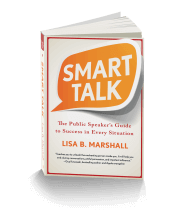7 Tips for Great Sit-Down Presentations
Not all presentations are given standing up. The Public Speaker offers advice for giving an effective sit-down presentation.
“Be sincere; be brief; be seated.”
Those are words of advice given by Franklin D. Roosevelt on the subject of public speaking. But for this segment, I’d like to switch that phrase around a little. What if you are giving a presentation that requires you to be seated in the first place? There are ways for you to be just as effective a speaker while sitting than you are standing.
Sponsor: Audible.com, the Internet’s leading provider of audiobooks with more than 150,000 downloadable titles across all types of literature, including fiction, non-fiction and periodicals. For a free audiobook of your choice, go to audiblepodcast lisa.

Giving an effective sit-down presentation is really not that different from giving one while you’re standing. Here are 7 pointers for engaging your audience while sitting:
Tip #1: Choose Your Seat Wisely
Where you sit can have a subtle affect on how strongly you come across to your audience. If possible, seat yourself next to a key decision-maker. If there isn’t one or you don’t know who it is, then try to position yourself more on one end of the group than in the middle. It will be easier to see everyone if they are more in front of you than if they’re seated on either side.
Tip #2: Use Your Entire Body (Yes, Even While Seated)
Even when you’re seated, body language can support your message or it can be a distraction. Keep your arms in an open position and not crossed in front of you. Hand gestures shouldn’t be too dramatic, but you can still use them to emphasize your words.
Keep your face relaxed and make sure your expressions support your words. Lean in to show emphasis. Focus on your listener as much as you would like them to be engaged when you are speaking.
Tip #3: Posture Is Still Important
Sit at your desk with both feet flat on the floor and speak clearly.
Since you are probably seated at a table, you may think the only visible part of your body is the upper half. Not so! Practice this first: sit at your desk with both feet flat on the floor and speak. Now cross your legs and speak. Do you feel a difference? Your body has shifted when you crossed your legs, and if you are seated at a table, you will look a little off balance to your audience. Stay grounded with both feet and legs evenly in front of you and your posture will be much better at conveying confidence.
Tip #4: Use Your Voice
One disadvantage of giving a sit-down presentation in a large room is that some people may not be able to see you. If they can’t hear you either, you’ll lose them. If necessary, request a hands-free wireless microphone so you can be heard.
One of the most effective methods of getting your audience’s attention with your voice is to speak quietly. I used to work with a guy who used this trick during meetings and it worked every time. When discussions got heated or everyone was talking over each other, he would raise himself up a little and start talking quietly and calmly. It was almost a whisper. If you were a fly on the wall in the room you would see everyone visibly turn toward him and lean in closer to hear what he had to say.
Tip #5: Treat it Like a Conversation

Tip #6: Be Flexible with the Organization
It is important to stay flexible with the organization of your presentation, but be sure to maintain structure so that your points are obvious and supported. That is, you need to be ready to move in any direction, while still maintaining control over the final result.
You may choose not to present with slides or if you do, feel free to use the slides in a different order than you planned. Also, consider planning fewer points than time would allow, this way you are building in extra time for your audience to actively participate and drive the direction of the presentation.
Tip #7: Presentation Basics Still Apply
Whether you’re standing or sitting, the basic rules still apply. Speak clearly, make eye contact, and stay engaged with your listeners. Because you may be closer to your audience, there is more pressure to speak confidently and not to sound nervous. So try to relax and enjoy yourself. Pretend you are only speaking to one person. Everyone will be ill at ease if they sense you are nervous.
FDR had the right idea when he said, “be brief” in the quote I referenced earlier. I’d like to think that it means to be concise, stick clearly to the point, and be in control of your setting. Sometimes we don’t have the luxury of preparing days beforehand, but whether last-minute or last-hour, formal or informal, your presentation will be well-received and remembered if you follow today’s 7 steps.

Do you struggle with difficult conversations? Do you procrastinate when it comes to delivering feedback? Do you know how to effectively persuade and influence others? Learn this and more in Smart Talk. Get your personally signed copy today!






